PHOTOS : VICTORIA FALLS, ZIMBABWE
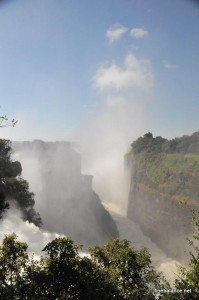 We had arranged with the folks at Hotel Chobe Marina at Kasane for a guided day trip across the border to Zimbabwe to see the famous Victoria Falls. One of the hotel staff accompanied us to the Kazungula border post, about a 20 minute ride away. Four countries meet in Kazangula: Botswana, Namibia, Zimbabwe and Zambia.  We crossed the border to Zimbabwe, completed the immigration formalities and were met by our Zimbabwe guide, Stanley. Seejo and I already had visas, so we got our entry permit stamped immediately. My mother, Dwiti and Asif needed to get a visa which was an unexpectedly painless process. We forked out $100 USD per visa , they stamped the passport and sent us off with Stanley. Â
We had arranged with the folks at Hotel Chobe Marina at Kasane for a guided day trip across the border to Zimbabwe to see the famous Victoria Falls. One of the hotel staff accompanied us to the Kazungula border post, about a 20 minute ride away. Four countries meet in Kazangula: Botswana, Namibia, Zimbabwe and Zambia.  We crossed the border to Zimbabwe, completed the immigration formalities and were met by our Zimbabwe guide, Stanley. Seejo and I already had visas, so we got our entry permit stamped immediately. My mother, Dwiti and Asif needed to get a visa which was an unexpectedly painless process. We forked out $100 USD per visa , they stamped the passport and sent us off with Stanley. Â
It was another 45 minutes drive through fairly empty roads (with the occasional giraffe or monkeys crossing the road)  to the parking lot of Wilderness Travel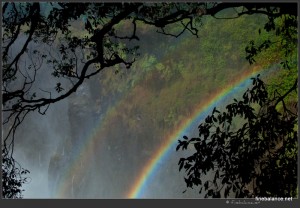 office near Victoria Falls. Even from the distance we could see the mists rising from the waterfalls & curling up like smoke in the sky. I remembered reading somewhere that the locals called the Falls – the Smoke that Thunders and decided that it was an apt name. Once Stanley  parked the car, he thrust some scruffy looking raincoats in our hands and went ahead to get our tickers to enter the Victoria Falls State Park.  It was a little difficult to maneuver the raincoats over our handbags (which we could not leave in the bus because it had our wallets and passports and in Seejo’s case his precious camera equipment). But then we discovered that it was kind of useless expecting the raincoats to protect our bags because the buttons on the raincoat were defective and none of us could really fasten our coats!
office near Victoria Falls. Even from the distance we could see the mists rising from the waterfalls & curling up like smoke in the sky. I remembered reading somewhere that the locals called the Falls – the Smoke that Thunders and decided that it was an apt name. Once Stanley  parked the car, he thrust some scruffy looking raincoats in our hands and went ahead to get our tickers to enter the Victoria Falls State Park.  It was a little difficult to maneuver the raincoats over our handbags (which we could not leave in the bus because it had our wallets and passports and in Seejo’s case his precious camera equipment). But then we discovered that it was kind of useless expecting the raincoats to protect our bags because the buttons on the raincoat were defective and none of us could really fasten our coats!
We started our tour of the Victoria Falls National Park from the foot of the Livingstone’s statue. David Livingstone was the first person from the western world to view the Falls sometime in the late 1850s.  Recalling explorer Stanley’s first historic meeting with Livingston, I was especially tickled to take a picture of our guide Stanley with the Livingston statue.  From there on we proceeded to through a guided loop , from the Zimbabwe side, we could see 4 of the 5 falls that make up the Victoria Falls.  The first of these falls was the Devil’s Cataract – with two beautiful rainbows bracketing the falls. To get a better view of this part of the waterfall, we descended about 70 steps and view it from the Cataract point.
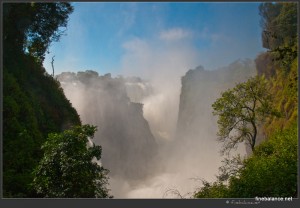 The Zambezi river plunges down a series of narrow but very high gorges with almost vertical walls to create this incredible natural wonder.  The water spray increased in intensity as we made our way through the various view points, so much so that it seemed as though we are caught in a torrential downpour.  We had no other protection but old raincoats with defective buttons and missing hoods so we ended up getting completely drenched. We could barely discern Livingstone island between the Main Falls and the Horseshoe falls. When the direction of the wind changed, we could perceive the trees on the island through a ghostly mist but most of the time, all we could see was a huge white curtain. And when we reached the view point of the horse shoe falls, the spray was beating down hard and it was all we could do to keep our eyes and feet on the trail. Dripping wet but very exhilarated, we stopped at the bridge connecting Zimbabwe to Zambia. Our guide pointed out that the middle of the bridge was a favourite point of bungee jumpers but none of us were feeling quite that reckless.  We stopped for a while , simply watching the magnificence of the fall and being awed by the power of the water as it plummeted below.
The Zambezi river plunges down a series of narrow but very high gorges with almost vertical walls to create this incredible natural wonder.  The water spray increased in intensity as we made our way through the various view points, so much so that it seemed as though we are caught in a torrential downpour.  We had no other protection but old raincoats with defective buttons and missing hoods so we ended up getting completely drenched. We could barely discern Livingstone island between the Main Falls and the Horseshoe falls. When the direction of the wind changed, we could perceive the trees on the island through a ghostly mist but most of the time, all we could see was a huge white curtain. And when we reached the view point of the horse shoe falls, the spray was beating down hard and it was all we could do to keep our eyes and feet on the trail. Dripping wet but very exhilarated, we stopped at the bridge connecting Zimbabwe to Zambia. Our guide pointed out that the middle of the bridge was a favourite point of bungee jumpers but none of us were feeling quite that reckless.  We stopped for a while , simply watching the magnificence of the fall and being awed by the power of the water as it plummeted below.
After seeing the falls, one of the questions I have always been asked is to compare it to Niagara. Since they are both beautiful natural wonders, it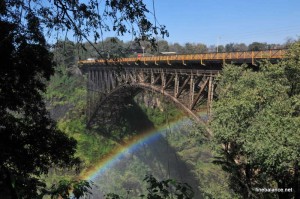 is difficult to rank them but there are differences. For one Niagara is definitely more accessible: one can pretty much drive to the falls and enjoy them without getting a drop on you. It has colorful light shows every evening, planned rides like the Maid of the Mist rides that take you near the base of the falls. Victoria Falls is like Niagara’s wild untamed cousin. The experience is far more raw (for lack of a better word), it is pretty much take it as is. And while the Niagara surpasses the Victoria in terms of the total annual volume of water, the Victoria is almost double the height and twice as wide as the Niagara.  And we didn’t really see the Victoria Falls as much as we experienced the majesty of the waterfall : we were soaked to the skin by the water spray.
is difficult to rank them but there are differences. For one Niagara is definitely more accessible: one can pretty much drive to the falls and enjoy them without getting a drop on you. It has colorful light shows every evening, planned rides like the Maid of the Mist rides that take you near the base of the falls. Victoria Falls is like Niagara’s wild untamed cousin. The experience is far more raw (for lack of a better word), it is pretty much take it as is. And while the Niagara surpasses the Victoria in terms of the total annual volume of water, the Victoria is almost double the height and twice as wide as the Niagara.  And we didn’t really see the Victoria Falls as much as we experienced the majesty of the waterfall : we were soaked to the skin by the water spray.
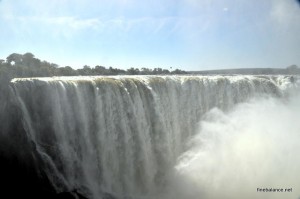 Stanley’s solution to our predicament was to take us to a local flea market. “By the time you finish buying a few items, you will be dryâ€, he assured us. We were dripping wet, so we were not feeling very charitable towards him at this point. Especially because he carried his own umbrella and stayed away from the view points and remained dry.  But our resentment vanished as soon as we reached the flea market. Local artisans displayed their wares : wooden bowls, metal & stone carved figurines, intricately designed walking sticks, masks of various size & shapes.—each article beautiful crafted from stone or wood or metal.  My favourite purchase was a Nyaminyami stick – a short walking stick with very complex figures carved from top to bottom with each section representing a critical part of the Zimbabwe life. Starting with Nayaminyami—a mythical river creature followed by the Zambezi river, the mopane tree, the local people and a pipe , each part of the stick represented an integral part of the local life.
Stanley’s solution to our predicament was to take us to a local flea market. “By the time you finish buying a few items, you will be dryâ€, he assured us. We were dripping wet, so we were not feeling very charitable towards him at this point. Especially because he carried his own umbrella and stayed away from the view points and remained dry.  But our resentment vanished as soon as we reached the flea market. Local artisans displayed their wares : wooden bowls, metal & stone carved figurines, intricately designed walking sticks, masks of various size & shapes.—each article beautiful crafted from stone or wood or metal.  My favourite purchase was a Nyaminyami stick – a short walking stick with very complex figures carved from top to bottom with each section representing a critical part of the Zimbabwe life. Starting with Nayaminyami—a mythical river creature followed by the Zambezi river, the mopane tree, the local people and a pipe , each part of the stick represented an integral part of the local life.
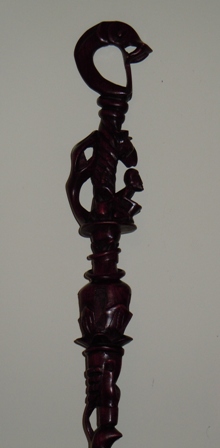 Competition amongst the traders was fierce, the moment we landed we were surrounded by the vendors – I felt as though I was the only bone in front of a pack of hungry dogs. We were pushed and pulled in all directions, promised incredible deals at the top of their voices, various items were shoved in our hands and for a couple of minutes, I was completely bewildered for the first few minutes till my Bombay background kicked in. These kind of high pressure sales tactics are common—so I could finally ignore the persistent sales men and focus on what I wanted to buy.  You need to haggle over the prices – the asking price in many cases was atleast three times what the final price ended up as. My mom was an expert at this kind of negotiations — having honed her skills buying from the vendors in Bombay— so we managed to get a lot of stuff for a real bargain. However the strangest experience was still to come.
Competition amongst the traders was fierce, the moment we landed we were surrounded by the vendors – I felt as though I was the only bone in front of a pack of hungry dogs. We were pushed and pulled in all directions, promised incredible deals at the top of their voices, various items were shoved in our hands and for a couple of minutes, I was completely bewildered for the first few minutes till my Bombay background kicked in. These kind of high pressure sales tactics are common—so I could finally ignore the persistent sales men and focus on what I wanted to buy.  You need to haggle over the prices – the asking price in many cases was atleast three times what the final price ended up as. My mom was an expert at this kind of negotiations — having honed her skills buying from the vendors in Bombay— so we managed to get a lot of stuff for a real bargain. However the strangest experience was still to come.
Soon we realized that the vendors were really not interested in money as much as they wanted some of our personal belongings. We were promised any item in the shop for my backpack or Dwiti’s t-shirt or Asif’s shoes. I knew the country was in trouble when they offered us an intricately carved wooden mask, that would have cost us atleast $30 in US for Seejo’s dirty wet socks. Since there is no production in Zimbabwe, consumer items were difficult to obtain.  We soon realized that the Zimbabwe’s economy was in such shambles that the country had no operational currency. Due to the lack of goods, the locals had resorted to the age old practice of bartering.
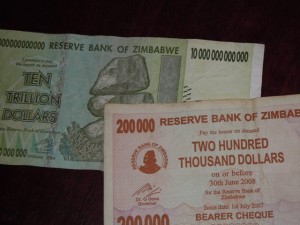 Zimbabwe’s economic collapse was rather sudden. Zimbabwe had a fairly strong agricultural economy with most of the farms controlled by the minority white population. President Mugabe sanctioned his land reforms for equitable distribution of farms which ended up in forcibly transferring the ownership of farms to the blacks—but members of his own tribe. Since the blacks did not have any experience in managing the farms, agricultural production plummeted and the economy quickly collapsed. Most of the white Zimbabweans left the country. Currency devalued and people who had money in the banks suddenly became paupers. One of the local businessmen told us that in about a year or so about 10 zeros fell off the currency. The currency inflated so much that notes of 10 trillion dollars and 50 trillion dollars were printed—which was probably worth only a few dollars in USD. Last year, they dropped even lower so much that the local currency was stopped. Locals now use US dollars, or Pula or Rand to purchase their milk and bread.
Zimbabwe’s economic collapse was rather sudden. Zimbabwe had a fairly strong agricultural economy with most of the farms controlled by the minority white population. President Mugabe sanctioned his land reforms for equitable distribution of farms which ended up in forcibly transferring the ownership of farms to the blacks—but members of his own tribe. Since the blacks did not have any experience in managing the farms, agricultural production plummeted and the economy quickly collapsed. Most of the white Zimbabweans left the country. Currency devalued and people who had money in the banks suddenly became paupers. One of the local businessmen told us that in about a year or so about 10 zeros fell off the currency. The currency inflated so much that notes of 10 trillion dollars and 50 trillion dollars were printed—which was probably worth only a few dollars in USD. Last year, they dropped even lower so much that the local currency was stopped. Locals now use US dollars, or Pula or Rand to purchase their milk and bread.
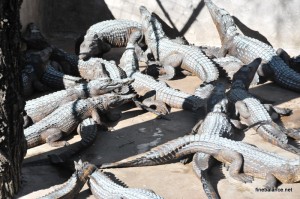 As we made our way to Hotel Ilala for our lunch, our guide assured us that the economy is improving and the people who left are slowly returning. The luxuriousness of Hotel Ilala, the beautifully landscaped lawns, the large swimming pools, the buffet of food was in stark contrast to the poverty outside the hotel. We did have a sumptuous lunch and dried ourselves before heading back to Botswana. However we had one last point in our Zimbabwe tour—a crocodile farm.  It was quickly clear to us that this was no animal park but a honest to goodness farm where
As we made our way to Hotel Ilala for our lunch, our guide assured us that the economy is improving and the people who left are slowly returning. The luxuriousness of Hotel Ilala, the beautifully landscaped lawns, the large swimming pools, the buffet of food was in stark contrast to the poverty outside the hotel. We did have a sumptuous lunch and dried ourselves before heading back to Botswana. However we had one last point in our Zimbabwe tour—a crocodile farm.  It was quickly clear to us that this was no animal park but a honest to goodness farm where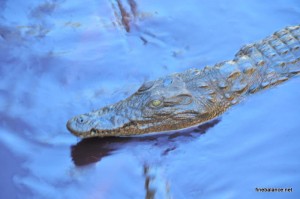 crocodiles are raised for their skin to make leather goods.  A young girl named Marvelous showed us around (people here had truly fantastic names, the waiter at the hotel Ilala was named “Giftâ€! ) the farm. There were multiple large pools with each one having about 50-100 crocodiles , in some cases the animals were piled over each other. Each pool had a crocodile of a different age group – the yearlings were more prized for their skin than the older ones. Some pools had chemically colored water to impart particular hues to the crocodile skin, such as red or indigo.
crocodiles are raised for their skin to make leather goods.  A young girl named Marvelous showed us around (people here had truly fantastic names, the waiter at the hotel Ilala was named “Giftâ€! ) the farm. There were multiple large pools with each one having about 50-100 crocodiles , in some cases the animals were piled over each other. Each pool had a crocodile of a different age group – the yearlings were more prized for their skin than the older ones. Some pools had chemically colored water to impart particular hues to the crocodile skin, such as red or indigo.
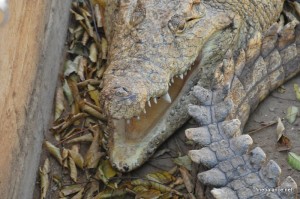 That was the end of the day for us. Stanley dropped us at the Botswana border where The Chobe Marina people were waiting to pick us up and take us back to the hotel. Later in the evening, while relaxing in the small balcony in our hotel in Botswana, looking across the Chobe River to Namibia, I realized that we had actually seen four different countries that day.
That was the end of the day for us. Stanley dropped us at the Botswana border where The Chobe Marina people were waiting to pick us up and take us back to the hotel. Later in the evening, while relaxing in the small balcony in our hotel in Botswana, looking across the Chobe River to Namibia, I realized that we had actually seen four different countries that day.
